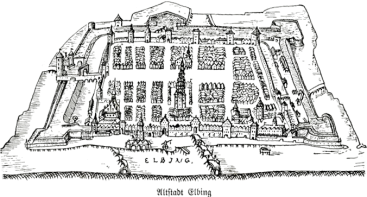Beginnings of the city reach back to 1237. It was then that on the bank of Elbląg river the Teutonic Knights started the construction of a defensive castle. Around it a trading settlement grew. In 1246 the place received Lübeck law town privileges. Back then the main national seat of the Teutonic Order was found in Elbląg.
In 14th century Elbląg was an important port center and belonged to the Hanseatic League. The archeological excavations in the old town prove the wealth of former citizens of Elbląg. The archeologists find thousands of products made of amber, ceramic, glass, metals, etc. These prove the vivid trade contacts of the Elbląg inhabitants with – among others - Germany, Scandinavia, England and the Netherlands.
Another important date in the history of the town was its 1440 accession to the Prussian Confederation. After the 1410 Battle of Grunwald Elbląg paid homage to the Polish King Władysław Jagiełło, offering him the conquered Teutonic castle. But it was not until the Second Peace of Thorn (1466) that Elbląg became part of the Polish state. The town enjoyed numerous privileges from the Polish kings and became an important maritime port. Wars that ravaged those areas in 16th and 17th centuries brought plagues, robberies and forced contributions.
After 1st Partitioning of Poland in 1772 Elbląg was incorporated in the Prussian state. 19th century revived the city. Elbląg became part of railway route. Also the Elbląg Canal was commissioned, new production facilities, including a brewery, cigar, railroad engine and car factories were built. What was of special importance was the shipyard established by Ferdinand Schichau. Torpedo boats, U-boats and railway engines were among products of Elbląg.
In 1945 the town returned to Poland. The war saw some 65% of the city destroyed. The Old Town suffered the most. The historic town houses were in ruins, some of the damaged ones were demolished. Over the years new workplaces and housing settlements were built. The initiative of the town authorities lead to creation, in 1998, of the Baltic Euroregion – one of the largest Euroregions of Europe, with Elbląg as a member.
Today Elbląg has 124 thousand residents, and is located on banks of river of the same name, in the north-western part of Warmian-Masurian Voivodeship, near the Vistula Lagoon. Situated at the national route no. 7 (Warsaw-Gdańsk) and the so called “Berlin Highway” – a road to Kaliningrad, 60 km away from Gdańsk and just 50 from Russian-Polish border, 100 km away from Kaliningrad Elbląg is a dynamically developing city (one of the district cities of the Polish law) a center for industry, science and culture and an attractive tourist location. It is also a maritime port.
Under the article a link to downloadable pdf file with more detailed history of Elbląg.

